John of Gaunt
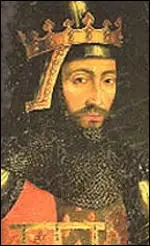
John of Gaunt, the fourth son of Edward III and Philippa of Hainault, was born at St Bavo's Abbey, Ghent, on 6th March 1340. He was brought up in the household of Edward, the Black Prince, and "was soon initiated into the strenuous military traditions of the Plantagenet family". (1)
Gaunt was on his father's ship during the Anglo-Castilian sea battle off Winchelsea in August 1350 and was knighted at the start of the Norman campaign in July 1355. He also served with his father in Scotland in 1356.
The Black Prince arranged for John of Gaunt to marry Blanche of Lancaster, his third cousin, in 1359 (both were great-great-grandchildren of King Henry III). On the death of his father-in-law, Henry of Grosmont, the 1st Duke of Lancaster, in 1361, John received half his lands, the title "Earl of Lancaster", and distinction as the greatest landowner in the north of England. (2)
At the age of twenty-two John of Gaunt was the richest nobleman in England - a status he was to retain throughout his life. The duchy of Lancaster estates yielded about £12,000 a year, an income at least double the amount enjoyed by any contemporary English magnate. (3)
According to Jean Froissart Blanche was "young and pretty" and she gave birth to seven children, three of whom survived infancy: Philippa (1360), Elizabeth (1363) and Henry of Bolingbroke (1367). Blanche died on 12th September 1368, probably from the Black Death. (4)
John of Gaunt: Military Commander
Edward III was in poor health and his son John of Gaunt became an important figure in the royal court. He was also sent on several diplomatic missions. In April 1367, his command of the English vanguard at Nájera increased his reputation as a military general. The Scottish Parliament even discussed the possibility of John of Gaunt succeeding the childless David II as king of Scotland. (5)
On 21st September 1371, John of Gaunt married Constance of Castile, the daughter of Peter of Castile, the King of Castile, who died in 1369. Gaunt used the marriage to claim the crown of Castile. However, Henry of Castile, the illigetimate son of Alfonso XI, became the King of Castile. The duke was formally authorized to use the Castilian royal titles by Edward III on 30 January 1372. A plan to send an invasion force was cancelled in October 1372. (6)
John's oldest brother, Edward, the Black Prince, had been the commander of the English army during the Hundred Years War, but suffering from repeated attacks of what was probably dysentery, he was forced to return to England. (7) John of Gaunt, was now asked to replace him in France and in April 1373, his army of 6,000 men departed from Dover. "Stiff French resistance kept the English forces away from the Paris basin, however, and forced the duke to march eastwards, to Rheims and Troyes, and then southwards through the Auvergne to Aquitaine, which the duke and his army reached in December." John returned to England in April 1374. (8)
In desperate need for money to fund the war, a Parliament was held in April 1376. John of Gaunt was the royal family's representative as both his father and elder brother were too ill to attend (his brother Edward died on 8th June). Members of the House of Commons complained about the heavy incidence of taxation and the consistent lack of military success. His support of John Wycliffe suggested that he was a religious reformer and this caused problems with church leaders. (9)
February, 1377, Wycliffe was told to appear before Archbishop Simon Sudbury and charged with seditious preaching. Anne Hudson has argued: "Wycliffe's teaching at this point seems to have offended on three matters: that the pope's excommunication was invalid, and that any priest, if he had power, could pronounce release as well as the pope; that kings and lords cannot grant anything perpetually to the church, since the lay powers can deprive erring clerics of their temporalities; that temporal lords in need could legitimately remove the wealth of possessioners." (10)
The Poll-Tax
In 1377 the government introduced a poll-tax where four pence was to be taken from every man and woman over the age of fourteen. "This was a huge shock: taxation had never before been universal, and four pence was the equivalent of three days' labour to simple farmhands at the rates set in the Statute of Labourers". Edward III died soon afterwards and John of Gaunt took the blame for the new tax. (11)
The leading magnates feared that John of Gaunt would claim the throne. They therefore promoted the idea, that his ten-year-old grandson, should become king. Richard II was crowned in July 1377. Thomas Walsingham described it as "a day of joy and gladness.... the long-awaited day of the renewal of peace and of the laws of the land, long exiled by the weakness of an aged king and the greed of his courtiers and servants." (12)
In 1379 Richard II called a parliament to raise money to pay for the continuing war against the French. After much debate it was decided to impose another poll tax. This time it was to be a graduated tax, which meant that the richer you were, the more tax you paid. For example, the Duke of Lancaster and the Archbishop of Canterbury had to pay £6.13s.4d., the Bishop of London, 80 shillings, wealthy merchants, 20 shillings, but peasants were only charged 4d.
In 1380 John of Gaunt and his army was sent north to deal with problems on the northern border. The trouble began when pirates operating out of Hull and Newcastle. had captured a Scottish ship. The Scots reacted to the loss by breaching the border, terrorising the northern counties and looting Penrith. According to Dan Jones "protecting the northern border certainly held some private interest for him; but he was also a champion of the rights of the Crown - a trait that often saw him unfairly characterised as having personal ambitions to the throne." (12a)
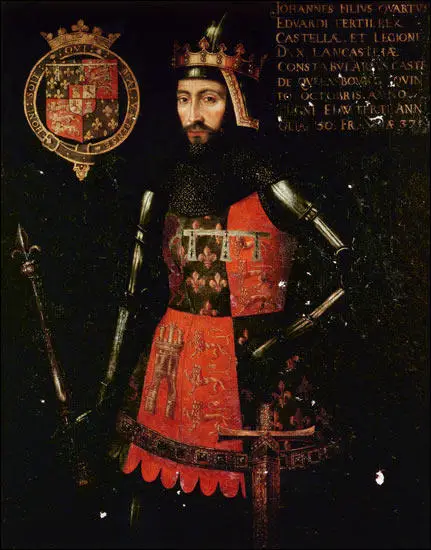
John of Gaunt, the Duke of Lancaster (c. 1620)
While he was away, Simon Sudbury, the Archbishop of Canterbury, suggested a new poll tax of three groats (one shilling) per head over the age of fifteen. "There was a maximum payment of twenty shillings from men whose families and households numbered more than twenty, thus ensuring that the rich paid less than the poor. A shilling was a considerable sum for a working man, almost a week's wages. A family might include old persons past work and other dependents, and the head of the family became liable for one shilling on each of their 'polls'. This was basically a tax on the labouring classes." (13)
The peasants felt it was unfair that they should pay the same as the rich. They also did not feel that the tax was offering them any benefits. For example, the English government seemed to be unable to protect people living on the south coast from French raiders. Most peasants at this time only had an income of about one groat per week. This was especially a problem for large families. For many, the only way they could pay the tax was by selling their possessions. John Wycliffe gave a sermon where he argued: "Lords do wrong to poor men by unreasonable taxes... and they perish from hunger and thirst and cold, and their children also. And in this manner the lords eat and drink poor men's flesh and blood." (14)
John Ball toured Kent giving sermons attacking the poll tax. When the Archbishop of Canterbury, heard about this he gave orders that Ball should not be allowed to preach in church. Ball responded by giving talks on village greens. The Archbishop now gave instructions that all people found listening to Ball's sermons should be punished. When this failed to work, Ball was arrested and in April 1381 he was sent to Maidstone Prison. (15) At his trial it was claimed that Ball told the court he would be "released by twenty thousand armed men". (16)
The Peasants Revolt
In May 1381, Thomas Bampton, the Tax Commissioner for the Essex area, reported to the king that the people of Fobbing were refusing to pay their poll tax. It was decided to send a Chief Justice and a few soldiers to the village. It was thought that if a few of the ringleaders were executed the rest of the village would be frightened into paying the tax. However, when Chief Justice Sir Robert Belknap arrived, he was attacked by the villagers. (17)
Belknap was forced to sign a document promising not to take any further part in the collection of the poll tax. According to the Anonimalle Chronicle of St Mary's: "The Commons rose against him and came before him to tell him... he was maliciously proposing to undo them... Accordingly they made him swear on the Bible that never again would he hold such sessions nor act as Justice in such inquests... And Sir Robert travelled home as quickly as possible." (18)
After releasing the Chief Justice, some of the villagers looted and set fire to the home of John Sewale, the Sheriff of Essex. Tax collectors were executed and their heads were put on poles and paraded around the neighbouring villages. The people responsible sent out messages to the villages of Essex and Kent asking for their support in the fight against the poll tax. (19)

Many peasants decided that it was time to support the ideas proposed by John Ball and his followers. It was not long before Wat Tyler, a former soldier in the Hundred Years War, emerged as the leader of the peasants. Tyler's first decision was to march to Maidstone to free John Ball from prison. "John Ball had been set free and was safe among the commons of Kent, and he was bursting to pour out the passionate words which had been bottled up for three months, words which were exactly what his audience wanted to hear." (20)
Charles Poulsen, the author of The English Rebels (1984) has pointed out that it was very important for the peasants to be led by a religious figure: "For some twenty years he had wandered the country as a kind of Christian agitator, denouncing the rich and their exploitation of the poor, calling for social justice and freeman and a society based on fraternity and the equality of all people." John Ball was needed as their leader because alone of the rebels, he had access to the word of God. "John Ball quickly assumed his place as the theoretician of the rising and its spiritual father. Whatever the masses thought of the temporal Church, they all considered themselves to be good Catholics." (21)
On 5th June there was a revolt at Dartford and two days later Rochester Castle was taken. The peasants arrived in Canterbury on 10th June. Here they took over the archbishop's palace, destroyed legal documents and released prisoners from the town's prison. More and more peasants decided to take action. Manor houses were broken into and documents were destroyed. These records included the villeins' names, the rent they paid and the services they carried out. What had originally started as a protest against the poll tax now became an attempt to destroy the feudal system. (22)
The peasants decided to go to London to see Richard II. As the king was only fourteen-years-old, they blamed his advisers for the poll tax. The peasants hoped that once the king knew about their problems, he would do something to solve them. The rebels reached the outskirts of the city on 12 June. It has been estimated that approximately 30,000 peasants had marched to London. At Blackheath, John Ball gave one of his famous sermons on the need for "freedom and equality". (23)
Wat Tyler also spoke to the rebels. He told them: "Remember, we come not as thieves and robbers. We come seeking social justice." Henry Knighton records: "The rebels returned to the New Temple which belonged to the prior of Clerkenwell... and tore up with their axes all the church books, charters and records discovered in the chests and burnt them... One of the criminals chose a fine piece of silver and hid it in his lap; when his fellows saw him carrying it, they threw him, together with his prize, into the fire, saying they were lovers of truth and justice, not robbers and thieves." (24)
Charles Poulsen praises Wat Tyler as learning the "lessons of organisation and discipline" when in the army and in showing the "same pride in the customs and manners of his own class as the noblest baron would for his". (25) The medieval historians were less complimentary and Thomas Walsingham described him as a "cunning man, endowed with much sense if he had applied his intelligence to good purposes". (26)
John of Gaunt was still in Scotland with the English Army when these events took place. King Richard II sent a message to bring his soldiers, an estimated 20,000 men, back to London. However, the message did not arrive in time for him to take effective action. Dan Jones, the author of Summer of Blood: The Peasants' Revolt (2009), has pointed out: "Some four hundred miles from the worst crisis of order the country had ever known, the most experienced and powerful noble in the land was left exiled and impotent." (27)
Richard II gave orders for the peasants to be locked out of London. However, some Londoners who sympathised with the peasants arranged for the city gates to be left open. Jean Froissart claims that some 40,000 to 50,000 citizens, about half of the city's inhabitants, were ready to welcome the "True Commons". (28) When the rebels entered the city, the king and his advisers withdrew to the Tower of London. Many poor people living in London decided to join the rebellion. Together they began to destroy the property of the king's senior officials. They also freed the inmates of Marshalsea Prison. (29)
Part of the English Army was at sea bound for Portugal whereas the rest were with John of Gaunt in Scotland. (30) Thomas Walsingham tells us that the king was being protected in the Tower by "six hundred warlike men instructed in arms, brave men, and most experienced, and six hundred archers". Walsingham adds that they "all had so lost heart that you would have thought them more like dead men than living; the memory of their former vigour and glory was extinguished". Walsingham points out that they did not want to fight and suggests they may have been on the side of the peasants. (31)
John Ball sent a message to Richard II stating that the rising was not against his authority as the people only wished only to deliver him and his kingdom from traitors. Ball also asked the king to meet with him at Blackheath. Archbishop Simon Sudbury and Robert Hales, the treasurer, both objects of the people's hatred, warned against meeting the "shoeless ruffians", whereas others, such as William de Montagu, the Earl of Salisbury, urged that the king played for time by pretending that he desired a negotiated agreement. (32)
Richard II's biographer, Anthony Tuck, has pointed out: "Richard's own part in the discussions is almost impossible to determine, though some historians have suggested that he took the initiative in seeking to negotiate with the rebels, despite the fact that he was only fourteen when the rebellion occurred. Even before the Kentish rebels entered London, Richard had apparently suggested negotiation with their leaders at Greenwich, but the talks had broken down almost as soon as they began." (33)
Richard II agreed to meet the rebels outside the town walls at Mile End on 14th June, 1381. Most of his soldiers remained behind. Charles Oman, the author of The Great Revolt of 1381 (1906), pointed the "ride to Mile End was perilous: at any moment the crowd might have broken loose, and the King and all his party might have perished... nevertheless, though surrounded all the way by a noisy and boisterous multitude, Richard and his party ultimately reached Mile End". (34)

John Ball at Mile End from Jean Froissart, Chronicles (c. 1470)
When the king met the rebels at 8.00 a.m. he asked them what they wanted. Wat Tyler explained the demands of the rebels. This includes the end of all feudal services, the freedom to buy and sell all goods, and a free pardon for all offences committed during the rebellion. Tyler also asked for a rent limit of 4d per acre and an end to feudal fines through the manor courts. Finally, he asked that no "man should be compelled to work except by employment under a regularly reviewed contract". (35)
The king immediately granted these demands. Wat Tyler also claimed that the king's officers in charge of the poll tax were guilty of corruption and should be executed. The king replied that all people found guilty of corruption would be punished by law. The king agreed to these proposals and 30 clerks were instructed to write out charters giving peasants their freedom. After receiving their charters the vast majority of peasants went home. (36)
G. R. Kesteven, the author of The Peasants' Revolt (1965), has pointed out that the king and his officials had no intention of carrying out the promises made at this meeting, they "were merely using those promises to disperse the rebels". (37) However, Wat Tyler and John Ball were not convinced by the word given by the king and along with 30,000 of the rebels stayed in London. (38)
While the king was in Mile End discussing an agreement with the king, another group of peasants marched to the Tower of London. There were about 600 soldiers defending the Tower but they decided not to fight the rebel army. Simon Sudbury (Archbishop of Canterbury), Robert Hales (King's Treasurer) and John Legge (Tax Commissioner), were taken from the Tower and executed. Their heads were then placed on poles and paraded through the streets of cheering Londoners. (39)
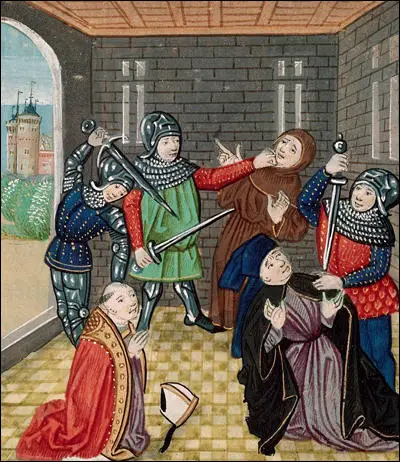
The killing of Archbishop Simon Sudbury and Robert Hales
from Jean Froissart, Chronicles (c. 1470)
Rodney Hilton argues that the rebels wanted revenge on all those involved in the levying of taxes or the administrating the legal system. Roger Leggett, one of the most important government lawyers was also killed. "They attacked not only the lawyers themselves - attorneys, pleaders, clerks of the courts - but others closely associated with the judicial processes... The hostility to lawyers and to legal records was not of course peculiar to the Londoners. The widespread destruction of manorial court records is well-known" during the rebellion. (40)
The rebels also attacked foreign workers living in London. "The commons made proclamation that every one who could lay hands on Flemings or any other strangers of other nations might cut off their heads". (41) It has been claimed that "some 150 or 160 unhappy foreigners were murdered in various places - thirty-five Flemings in one batch were dragged out of the church of St. Martin in the Vintry, and beheaded on the same block... The Lombards also suffered, and their houses yielded much valuable plunder." (42)
Death of Wat Tyler and John Ball
It was agreed that another meeting should take place between Richard II and the leaders of the rebels at Smithfield on 15th June, 1381. William Walworth rode "over to the rebels and summoned Wat Tyler to meet the king, and mounted on a little pony, accompanied by only one attendant bearing the rebel banner, he obeyed". When he joined the king he put forward another list of demands that included: the removal of the lordship system, the distribution of the wealth of the church to the poor, a reduction in the number of bishops, and a guarantee that in future there would be no more villeins. (43)
Richard II said he would do what he could. Wat Tyler was not satisfied by this reply. He called for a drink of water to rinse out his mouth. This was seen as extremely rude behaviour, especially as Tyler had not removed his hood when talking to the king. One of Richard's party shouted out that Tyler was "the greatest thief and robber in Kent". The author of the Anonimalle Chronicle of St Mary's claims: "For these words Wat wanted to strike the valet with his dagger, and would have killed him in the king's presence; but because he tried to do so, the Mayor of London, William of Walworth... arrested him... Wat stabbed the mayor with his dagger in the body in great anger. But, as it pleased God, the mayor was wearing armour and took no harm.. he struck back at the said Wat, giving him a deep cut in the neck, and then a great blow on the head. And during the scuffle a valet of the king's household drew his sword, and ran Wat two or three times through the body... Wat was carried by a group of the commons to the hospital for the poor near St Bartholomew's, and put to bed. The mayor went there and found him, and had him carried out to the middle of Smithfield, in the presence of his companions, and had him beheaded." (44)
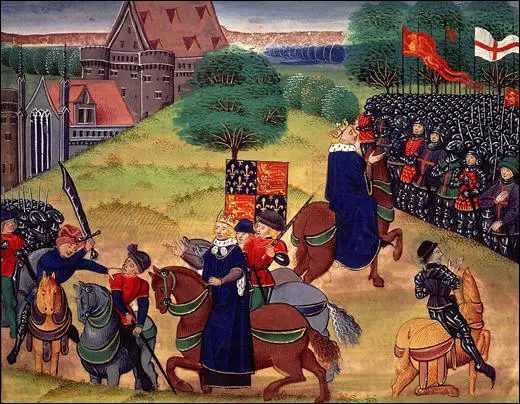
The death of Wat Tyler from Jean Froissart, Chronicles (c. 1470)
The peasants raised their weapons and for a moment it looked as though there was going to be fighting between the king's soldiers and the peasants. However, Richard rode over to them and said: "Will you shoot your king? I will be your chief and captain, you shall have from me that which you seek " He then spoke to them for some time and eventually they agreed to go back to their villages. (45)
Chroniclers such as Henry Knighton and Thomas Walsingham suggested that these events were unplanned and unexpected. However, modern historians have doubts about this version of events. Anthony Tuck has argued: "The rapid arrival of the militia suggests some element of advance planning, and those around the king, even perhaps the king himself, may have intended to create an opportunity to kill or capture Tyler and separate him from the main body of his followers. If this is so, it was a risky strategy, as the Mile End meeting had been, and again Richard's personal courage is not in doubt." (46)
An army, led by Thomas of Woodstock, John of Gaunt's younger brother, was sent into Essex to crush the rebels. A battle between the peasants and the King's army took place near the village of Billericay on 28th June. The king's army was experienced and well-armed and the peasants were easily defeated. It is believed that over 500 peasants were killed during the battle. The remaining rebels fled to Colchester, where they tried in vain to persuade the towns-people to support them. They then fled to Huntingdon but the towns people there chased them off to Ramsey Abbey where twenty-five were slain. (47)
Richard II
Richard II was not a very successful military commander. His biographer, Peter Earle, points out: "Richard, son of the Black Prince, inherited only his father's outward appearance and none of his skills at war. Not that he was the coward or weakling of legend - on many occasions in his reign he was to display outstanding courage - but his was the courage of pride, not military prowess." This was reflected in a failed military expedition to Scotland in 1385. (48)
Richard's failure in Scotland encouraged the French to consider invading England. Charles VI assembled the largest force so far raised by either side during the Hundred Years War. This induced widespread panic and insecurity in England. Parliament met in October 1386, to consider the request from the chancellor, Michael de la Pole, for an unprecedented quadruple subsidy to cover the cost of defence against the threatened invasion. This was refused and the barons began to question the way Richard was ruling the country.
At first Parliament blamed Richard's advisors and his chancellor was impeached by the House of Commons on charges arising out of his conduct in office. De la Pole was found guilty and condemned to imprisonment, but Richard set aside the penalty and he retained his freedom. "Parliament then established a commission which was to hold office for a year and which was to conduct a thorough review of royal finances. It was to have control of the exchequer and the great and privy seals, and Richard was required to take an oath to abide by any ordinances it made." (49)
Richard raised an army against Parliament. Led by Robert de Vere, Duke of Ireland it was said to contained no more than 4,000 men. Rumours began to circulate that Richard had agreed to accept military support from France, and that he would place England under French military occupation. Thomas of Woodstock, Duke of Gloucester, and several other nobles, including Henry of Bolingbroke and Thomas Mowbray, Earl of Nottingham, mobilized an army of their retainers numbering 4,500 and marched on de Vere's army. The king's army was defeated at the Battle of Radcot Bridge on 19th December 1387. (50)
Richard was arrested and Woodstock threatened to have him executed because of his dealings with France. They eventually decided against it and instead forcing him to call a session of Parliament. Henry Knighton described it as the Merciless Parliament as it resulted in several of Richard's leading advisors, including Sir Nicholas Brembre, Simon de Burley and Robert Tresilian were executed. Alexander Neville, Archbishop of York, Robert de Vere and Michael de la Pole, all managed to escape to France where they died in exile. (51)
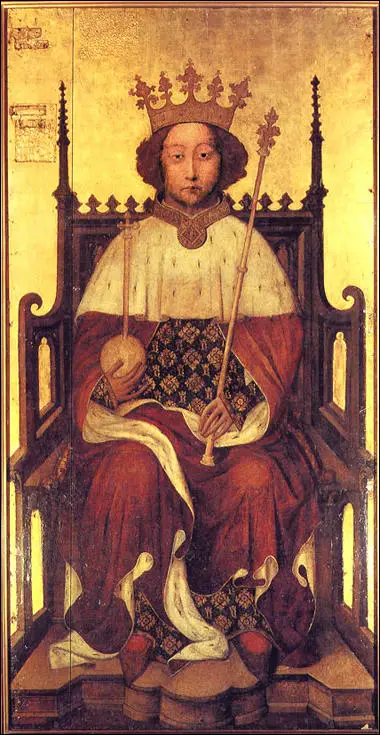
Richard II by unknown artist (c. 1395)
On 3rd May 1389 Richard was allowed back on the throne. This time he made no attempt to revive the style of government which had brought about the crisis of 1387 and for the time being no new inner circle of courtiers emerged to enjoy Richard's favour and patronage. John of Gaunt returned to England in November 1389 and pledged his support to Richard. The atmosphere of peace was to last for six years. During this period he had some diplomatic success. This included a settlement in Ireland in 1394 and two years later negotiated a truce with France. (52)
As soon as he felt strongly enough, Richard fought back against those who were responsible for ousting him from power in 1387. He ordered the arrest of Thomas of Woodstock, Duke of Gloucester, Richard FitzAlan, 11th Earl of Arundel and Thomas de Beauchamp, 12th Earl of Warwick. Gloucester was murdered soon afterwards and Arundel was executed on 21st September, 1397. Warwick made a full confession to attempting to overthrow the king, was banished for life to the Isle of Man. (53)
John of Gaunt, 1st Duke of Lancaster, died on 3rd February 1399.
Primary Sources
(1) Antonia Fraser, The Six Wives of Henry VIII (1992)
Lady Rochford attempted to paint herself as an innocent bystander who had somehow been at the other end of the room where the Queen was meeting Culpeper, without knowing what was going on. Catherine on the other hand reversed the image and described a woman, like Eve, who had persistently tempted her with seductive notions of dalliance; while Culpeper too took the line that Lady Rochford had 'provoked' him into a clandestine relationship with the Queen... Once again, as with the technicalities of the Queen's adultery, absolute truth - and thus relative blame - is impossible to establish.
Student Activities
The Peasants' Revolt (Answer Commentary)
Death of Wat Tyler (Answer Commentary)
Medieval Historians and John Ball (Answer Commentary)
Taxation in the Middle Ages (Answer Commentary)
Medieval and Modern Historians on King John (Answer Commentary)
King John and the Magna Carta (Answer Commentary)
Henry II: An Assessment (Answer Commentary)
Richard the Lionheart (Answer Commentary)
Christine de Pizan: A Feminist Historian (Answer Commentary)
The Growth of Female Literacy in the Middle Ages (Answer Commentary)
Women and Medieval Work (Answer Commentary)
The Medieval Village Economy (Answer Commentary)
Women and Medieval Farming (Answer Commentary)
Contemporary Accounts of the Black Death (Answer Commentary)
Disease in the 14th Century (Answer Commentary)
King Harold II and Stamford Bridge (Answer Commentary)
The Battle of Hastings (Answer Commentary)
William the Conqueror (Answer Commentary)
The Feudal System (Answer Commentary)
The Domesday Survey (Answer Commentary)
Thomas Becket and Henry II (Answer Commentary)
Why was Thomas Becket Murdered? (Answer Commentary)
Illuminated Manuscripts in the Middle Ages (Answer Commentary)

